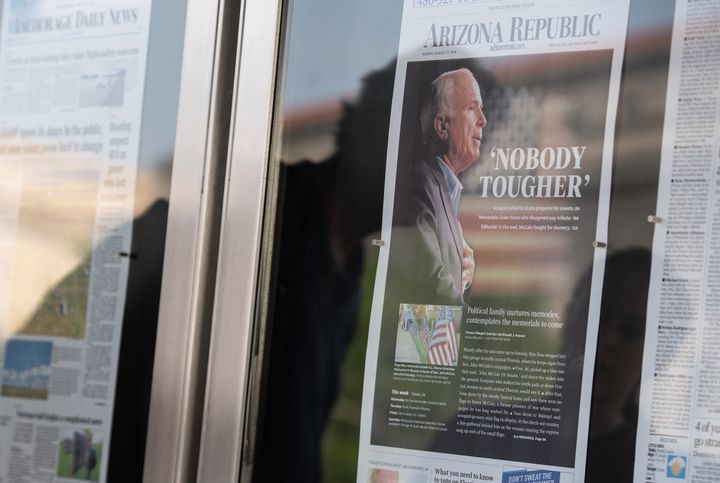Journalists who are women and people of color tend to earn lower salaries than their male and white counterparts in more than a dozen newsrooms run by the largest newspaper chain in the U.S., according to a new pay study conducted by the chain’s employees.
A group of reporters employed by Gannett undertook the analysis of salaries in 14 newsrooms operated by the news giant. They found that the median salary of a woman was 83% that of a man, or $9,800 less, while the median salary of a journalist of color was 90% that of a white journalist, or $5,200 less.
The authors noted that those disparities may be partly explained by the fact that women and people of color likely skew younger in the newsrooms, but they found gender and racial pay gaps persisted once they controlled for age and tenure.
The demographic data also showed that staffers at all but one of the 14 newsrooms in the study were whiter than the communities they covered.
The anonymous pay data for nearly 450 employees was obtained from the company by the journalists’ union, the NewsGuild-CWA, which represents workers at 41 Gannett properties.
In an email, Gannett spokesperson Lark-Marie Anton called the study a “misleading document” based on “a small subset of Gannett’s more than 250 newsrooms.” She said the company “strongly disagree[s] with its methodology and its findings.” In particular, she said, the study did not account for employees’ roles and responsibilities, which could explain lower or higher pay.
Rebekah Sanders, the consumer protection reporter at The Arizona Republic and one of the six journalists who penned the report, told HuffPost they wanted to analyze more newsrooms but had only incomplete data. She invited Gannett to release anonymous pay data from all its newsrooms for a complete picture.
Employees at The Arizona Republic and several other papers in the study are in the process of negotiating their first collective bargaining agreements with the company, and the analysis will certainly come up in contract talks.
“We feel like one of the most immediate places where Gannett can make things right is at the bargaining table,” Sanders said.

The study included newsrooms for The Indianapolis Star, The Florida Times-Union, The Memphis Commercial Appeal and The Milwaukee Journal Sentinel. Employees in non-journalism roles were not part of the analysis.
Gannett operates more than 250 newspapers. Several newsrooms in the study were acquired by the company in its 2019 merger with publisher GateHouse.
According to the authors, the pay inequities tended to be smaller at newsrooms that had organized long ago and greater at newsrooms that had only recently unionized. Union contracts tend to have minimum salary levels and scheduled across-the-board raises that can help reduce disparities over time.
One of the study’s limitations is that it does not reflect workers’ total years of experience in the industry, only in Gannett-owned newsrooms. Sanders said they were not able to obtain that data from the company. In 2016, The Washington Post questioned the findings of a similar pay study of its own newsroom because it couldn’t account for broader industry experience.
The disparities laid out in the report wouldn’t be unique to Gannett’s properties, coming on the heels of similar analyses at papers such as the Post and The New York Times. Unionized staffers at newspapers around the country, including HuffPost, have been agitating for more diverse newsrooms. (HuffPost employees are represented by the Writers Guild of America, East.)
Gannett recently conducted its own diversity analysis, finding that its newsrooms were 58% male and 79% white, and pledged to make a priority of equity and inclusion.
The Gannett study done by its own journalists found that the gender pay gap was particularly stark for women with long careers at their respective papers. Women with tenures of 30 years or more earned a median salary worth 63% that of men with similar lengths of service, a difference of $27,000. Sanders said the authors could not obtain historical pay data, but they suspect many of those women came in at very low salaries that hobbled their earnings for years to come.
Racial pay disparities were not equal across age groups. Journalists of color ages 40 to 50 tended to earn a median salary $7,000 below their white counterparts, but those older than 50 earned a median salary $3,000 above their white counterparts.
Sanders said that the analysis suggests the pay gap is smaller among younger journalists by both race and gender, but she still believes it’s a serious problem that hurts morale and makes it harder to retain talented journalists.
“At the Republic we have been seeing really high turnover of younger women and employees of color,” she said. “They have been recognizing how underpaid they are for their experience.”
